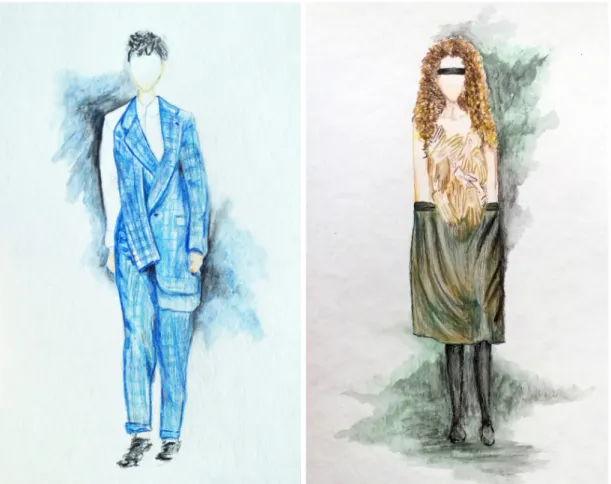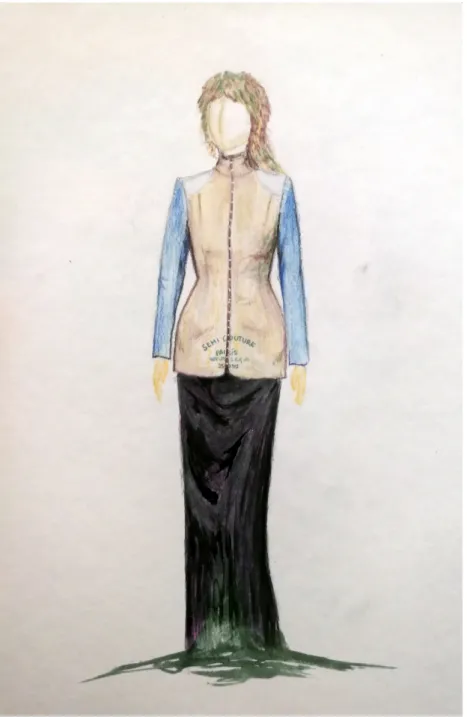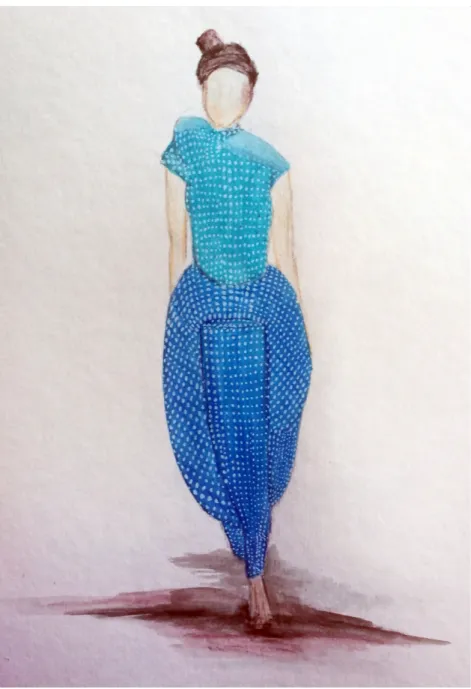Thoughts on: The Anti‐fashion – Deconstruction
Revisited
Nadica Maksimova
*Published: July 29, 2020
The term deconstructivism was first used in reference to fashion when Bill Cunningham applied it in the March 1990 issue of Details. (Hodge, Gill) In her 1993 article Coming Apart, Amy M. Spindler refers to deconstructivism as ‘the end of fashion as we know it’. In her words, the reluctant leader of the ‘revolutionary movement’ was Martin Margiela — the pioneer of the Royal Academy of Fine Arts in Antwerp, Belgium.1 The fashion processes that brought to the use of the term deconstructivism, however, initiated much earlier. Almost a decade before the pivotal moment described by Spindler — Margiela’s show in a vacant lot in Paris in October ’89 when finally, press and buyers fully understood that deconstructionism had arrived2— Rai Kawakubo and Yohji Yamamoto had their breakthrough in Paris.
Still, the common denominator ‘deconstructivism’, may not be the adequate term to use when reflect-ing on the fashion developments from the early 1980s on. ‘Anti-fashion’, (Fabbri) on the other hand, is a term that does not merely bond the work of the fashion designers to the work of the practitioners in other disciplines. On the contrary, it allows independent analysis of the conceptual and formal charac-teristics of the specific fashion movement and consequently leads towards a comparative study between different design disciplines. Once embarked on that disquisition journey, you start delving into the vast sea of diverse sources. The available videos3of the fashion shows of the period in question proved to be the perfect starting point for the cogitation on the Anti-fashion movement. Having in front of me the actual runaways, being able to observe the specific music, the moves and the attitude, allowed me to understand the spirit of the time, as well as the condition in which anti-fashion was taking place.
* Università di Bologna (Italy);[email protected]
1. Amy M. Spindler, “Coming Apart”, New York Times, July 25, 1993, https://www.nytimes.com/1993/07/25/style/ coming-apart.html
2. Spindler, “Coming Apart”
3. Fashion shows available on YouTube, playlist Fashion shows 80s, created December 2018,https://www.youtube.com/ playlist?list=PLAKuVqCf1F3biMkwxvYOiaqfl4rMXdFYQ
It is already at this stage of going through all the available 1980s fashion shows, interviews and testi-monials on Japanese designers, that one of the main characteristic of the Anti-fashion —the shock of the old— starts to pop up. The techniques used were not new, the anti-fashion rhetoric, however, was questioning everything known and professed on fashion up to that moment. As a matter of fact, both Kawakubo and Yamamoto were openly expressing their stand against the established system.4 The shock was also represented by the journalist of the time. The “inflammatory titles such as ‘After World War III’, ‘The monk and the kamikaze’, ‘The Japanese do Les Misérables’, ‘Japanese secondhand’ ”5and others were highlighting the discountenance towards the new aesthetics.
The anti-fashion is not concerned with formal aesthetics only. For the Japanese designers, the main point of interest and challenge was the concept of fashion. By continuously questioning the form, they were addressing the specific issues of the system. The ragged edges and crinkled fabrics, the atypical hemlines and loose-fitting layers falling over the body were present on the runaways from the early 1980s. Those were all adding to thesensation of the unfinished— one of the main traits of the anti-fashion. No matter the image of a work-in-progress, it is important to underline that the garments designed by Kawakubo and Yamamoto have always had the weight of the thoughtfully structured items. (Fabbri, Kawamura)
That very structure howbeit was barely observable. The silhouette was distorted; the deliberately cre-ated baggy looks were dominating the scenery, while layers of textile were wrapped around the body, which was becoming progressively unrecognisable. Theblurring of the boundariesis another impor-tant characteristic of the anti-fashion. It was difficult to delineate the confine between different cloth-ing parts, but more importantly, it was hard to define the limit between the body and the garment. In the January 1996 issue of Vogue Italia, Mats Gustafson designed the “’96 Lines”. The drawing rep-resenting Yamamoto’s lines reminds me of a structureless cloud where only the head of the figure is distinguishable.6 This blurring characteristic would be particularly evident in the 1990s designs of Rai Kawakubo in which, in a continuous dance of overlapping, the body and the garment were becoming one. Amongst the most prominent examples is her sleeveless A/W 1995 collection7, so as the iconic S/S 1997 collection,8where the body contour is everything but recognisable.
The illusion of a structureless piece of clothing was creating a sense of disturbance which was coming from within the form. The traditional garment lines were dismantled, but the garment in itself was not demolished nor damaged. Theopposition between disturbance and demolitionis probably the essen-tial feature of the Anti-fashion insofar it distinguishes the movement from the reconstruction practices and the aesthetics of damage employed by revivalist designers such John Galliano, Vivienne Westwood, Alexander McQueen and others.
By the 1990s, the previously explained anti-fashion characteristics were already deeply embedded in the practice of the Japanese designers. Those were also a distinguishing trait of the work of the emerging designers such as Martin Margiela. In the new decade, it will become clear that features such as the shock of the old, the unfinished, blurring of the boundaries and the opposition between disturbance and demolition were a result of a few interrelated construction practices.
4. Yamamoto in “Fashion! Anti-fashion,” a TV series documentary by Olivier Nicklaus, LALALA — ARTE France — INA, 2012, Video 54:51,https://www.youtube.com/watch?v=8kle_lPRtNs&t=437s
5. Patricia Mears, Skin + Bones: practices in fashion and architecture, ed. Brook Hodge (New York: Thames & Hudson, 2006), 33, 32.
6. “Linee ’96.” Vogue Italia, January, 1996, 134–141, retrieved fromhttps://search.proquest.com/docview/1824204733. 7. Fall 1995 Ready to wear Comme des Garcones, Vogue fashion shows, March 16, 1995, accessed on December 26, 2019,https:
//www.vogue.com/fashion-shows/fall-1995-ready-to-wear/comme-des-garcons. The blurring of the boundaries between the body and the garment is particularly evident in the looks 18–19, and 25 to 28.
8. Spring 1997 Ready to wear Comme des Garcones, Vogue fashion shows, accessed on December 26, 2019,https://www. vogue.com/fashion-shows/spring-1997-ready-to-wear/comme-des-garcons. The deformation of the silhouette is particu-larly emphasised in the looks 14 to 19, as well as in the final ones, 50 to 57.
• The displacement of the garment elementsis probably the oldest and easiest to notice. As early as 1985, Yamamoto would displace the collar and the sleeves putting them on the front of the bodice (Fig. 1a) or making them part of the draping skirt, while Kawakubo would eliminate the entire back part of a trench coat. In the 1990s, Margiela would take shirts and modify them as tops9. He would also take many gloves and transform them into pockets or a frontal part of a corset.10 (Fig. 1b) In the last decade of the twentieth century, Kawakubo would go further in twisting the sleeves, or entire, coats. Thus, making them an integral part of an atypical gown, a revisited collar or simply, using them like a vest bellow another dismantled coat.1112
• The inversion of the inside outis another method of construction of the anti-fashion garments. It was firstly employed in small experimentations during the 1980s but will be fully manifested in the works of Kawakubo and particularly Margiela in the 1990s. If Kawakubo was turning visible the inside of a trench coat, was showing off the remaining of the zippers or was inverting the sleeves,13Martin Margiela would go even further. He worked on a collection in which the pattern paper was surface material, the basting stitches and the shoulder pads were made visible, while the textile of the bodice was the linen of dressmaker dummies.1415 (Fig. 2) The collection(s)16 were a reference to the work-in-progress and homage to the not-so-well-known side of the fashion creation.
• The final construction method could be defined asadding of unconventional elements. In the 1980s Yamamoto’s clothing designs, the addition was constituted by layers of folded materials creating peculiar silhouette variation; in the 1990s Kawakubo developed a particular way of re-fashioning the idea of a garment. She would use rolls of lumpen textile and would add them to the regular garment17, creating in that manner a preternatural silhouette. The already men-tioned 1997 S/S runaway, was rightfully denominated ‘lumps and bumps’ show insofar it featured dresses stuffed with filler, therefore, deforming the body.18(Fig. 3)
9. Spring 1995 Ready to wear Martin Margiela, Vogue fashion shows, October 10, 1994, accessed on December 26, 2019https: //www.vogue.com/fashion-shows/spring-1995-ready-to-wear/maison-martin-margiela. The looks 2 to 4 give the idea of the unconventionally worn shirts, modified to be used as tops.
10. See looks 10 and 11 of Spring 2001 Ready to wear Martin Margiela, Vogue fashion shows, October 10, 2000, accessed on December 26, 2019https://www.vogue.com/fashion-shows/spring-2001-ready-to-wear/maison-martin-margiela 11. Spring 1995 Ready to wear Comme des Garcones, Vogue fashion shows, October 10, 1996, accessed on December 26,
2019,https://www.vogue.com/fashion-shows/spring-1995-ready-to-wear/comme-des-garcons. The displacement of tra-ditional elements is particularly visible in the looks 51, 58 to 62, 86 to 89, as well as in the final looks 96 to 100.
12. For displacement of the traditional elements, see looks 17, 33 to 35 and 52 of Fall 1992 Ready to wear Comme des Garcones,
Vogue fashion shows, March 23, 1992, accessed on December 27, 2019, https://www.vogue.com/fashion-shows/fall-1992-ready-to-wear/comme-des-garcons.
13. Spring 1992 Ready to wear Comme des Garcones, Vogue fashion shows, October 18, 1991, accessed on December 26, 2019, https://www.vogue.com/fashion-shows/spring-1992-ready-to-wear/comme-des-garcons. The inversion of the inside out is visible in the looks 29 to 34, particularly in 41 and 44, but also in the looks 89, 92, 93, 108 to 110 and others.
14. Spring 1997 Ready to wear Martin Margiela, Vogue fashion shows, October 2, 1996, accessed on December 26, 2019,https: //www.vogue.com/fashion-shows/spring-1997-ready-to-wear/maison-martin-margiela.
15. Fall 1997 Ready to wear Martin Margiela, Vogue fashion shows, March 2, 1997, Accessed on December 26, 2019,https: //www.vogue.com/fashion-shows/fall-1997-ready-to-wear/maison-martin-margiela.
16. The 1997 Spring and Fall collections were conceptually very similar and appear like continuation of one another. 17. See looks 34, 35 and 70 to 72 of the Fall 1994 Ready to wear Comme des Garcones, Vogue fashion shows, March 6, 1994,
accessed on December 27, 2019,https://www.vogue.com/fashion-shows/fall-1994-ready-to-wear/comme-des-garcons. 18. The Spring 1997 Ready to wear Comme des Garcones runway is particularly important insofar it contains many clothing
To conclude, I would turn the focus from the construction practices onto Martin Margiela’s runaways in the 1990s. Putting apart the actual garments and analysing the ways of presentation strictly, could, sometimes, result in precious conclusions. In the decade of emphasised femininity, exaggeration, and show for show sake, Margiela would question the concept of fashion runaway. In the era of the super-models, he chooses to hide the identity of the women presenting his designs.19 Sometimes, their eyes would be covered, with black tape20(Fig. 1) or deliberately chosen wigs.21In other occasions, the faces would be fully covered with untransparent material.22 Regardless of the approach, the identity of the models is always concealed. He went to the point of even eliminating the figure of the models, replacing them with lifeless mannequins23or employing lab technicians to present the garments as if those were ongoing experiments.24
Through his maverick fashion shows, he would critique the system, underlying again, the recognisable trait of the anti-fashion — the shock of (what was retained) old and outdated. In this line, I would fin-ish with a mention of a 1967 Vogue Italia advertisement.25The tricot underwear is advertised with the slogan “Voi non siete come un manichino fasciato — avete scoperto La Guinetta” meaning “You are not a banded mannequin — you have discovered La Guinetta.”26 Thirty years later, with his A/W 1998 show27, Margiela will convey the very opposite message, deconstructing in that manner, the outdated conceptions of fashion.
19. Fall 1995 Ready to wear Martin Margiela, Vogue fashion shows, March 1, 1995, accessed on December 27, 2019,https: //www.vogue.com/fashion-shows/fall-1995-ready-to-wear/maison-martin-margiela.
20. Spring 2001 Ready to wear Martin Margiela, Vogue fashion shows, October 10, 2000, accessed on December 27, 2019,https: //www.vogue.com/fashion-shows/spring-2001-ready-to-wear/maison-martin-margiela.
21. Fall 2000 Ready to wear Martin Margiela, Vogue fashion shows, March 2, 2000, accessed on December 27, 2019,https: //www.vogue.com/fashion-shows/fall-2000-ready-to-wear/maison-martin-margiela.
22. Spring 1996 Ready to wear Martin Margiela, Vogue fashion shows, September 16, 1995, accessed on December 26, 2019, https://www.vogue.com/fashion-shows/spring-1996-ready-to-wear/maison-martin-margiela.
23. Fall 1998 Ready to wear Martin Margiela, Vogue fashion shows, March 4, 1998, accessed on December 27, 2019,https: //www.vogue.com/fashion-shows/fall-1998-ready-to-wear/maison-martin-margiela.
24. Spring 1998 Ready to wear Martin Margiela, Vogue fashion shows, October 2, 1997, accessed on December 27, 2019,https: //www.vogue.com/fashion-shows/spring-1998-ready-to-wear/maison-martin-margiela.
25. “Advertisement: Guinetta-Shorts (Du Pont).” Vogue Italia, October, 1967, 14–19, retrieved fromhttps://search.proquest. com/docview/1819412741.
26. free translation
27. For visual comparison, please check the Fall 1998 Ready to wear Martin Margiela show. https://www.vogue.com/fashion-shows/fall-1998-ready-to-wear/maison-martin-margiela
Figure 1: on the left: illustration inspired by Comme des Garçons S/S 1995, look 62/100, available at
https://www.vogue.com/fashion-shows/spring-1995-ready-to-wear/comme-des-garcons/slideshow/collection#62© Nadica Maksimova
on the right: illustration inspired by Martin Margiela S/S 2001, look 11/26,
available at https://www.vogue.com/fashion-shows/spring-2001-ready-to-wear/maison-martin-margiela/slideshow/collection#11© Nadica Maksimova
Figure 2: illustration inspired by Martin Margiela A/W 1997, look 12/41,
available at https://www.vogue.com/fashion-shows/fall-1997-ready-to-wear/maison-martin-margiela/slideshow/collection#12© Nadica Maksimova
Figure 3: illustration inspired by Comme des Garçons S/S 1997, look 8/57,
available at https://www.vogue.com/fashion-shows/spring-1997-ready-to-wear/comme-des-garcons/slideshow/collection#8© Nadica Maksimova
Bibliography
Fabbri, Fabriano. L’Orizzonte degli eventi/The Event Horizon. Bologna: Atlante Srl, 2013.
Gill, Alison. “Deconstruction Fashion: the making of unfinished, decomposing and re-assembled clothes.” Fashion Theory The Journal of Dress Body & Culture (Oxford: Berg) Vol. 2, issue 1 (February 1998): 25–49. 1998.https://doi.org/10.2752/136270498779754489
Hodge, Brook (ed.). Skin + Bones: Parallel practices in fashion and architecture. New York: Thames & Hudson, 2006.
Kawamura, Yuniya. Dress, Body, Culture: The Japanese Revolution in Paris Fashion. Oxford: Berg, 2004.
Spindler, Amy M. “Coming Apart.” New York Times, July 25, 1993.https://www.nytimes.com/1993/ 07/25/style/coming-apart.html
“Fashion! Anti-fashion”, a TV series documentary by Olivier Nicklaus, LALALA — ARTE France — INA, 2012, Video 54:51.https://www.youtube.com/watch?v=8kle_lPRtNs&t=437s.


